
Two total eclipses of the Moon, an all-planet array across the sky, and a fine close approach of Mars highlight the astronomical year of 2022.
In this blog, I provide my selection of the best sky sights of 2022. I focus on events you can actually see, and from North America. I also emphasize photogenic events, such as gatherings of the Moon and planets at dawn or dusk, and the low Full Moons of summer.
The sky charts are for my longitude in Alberta and my home latitude of 51° N, farther north than many readers will likely live. From more southerly latitudes in North America, the low planet gatherings at dawn or dusk will be more obvious, with the objects higher and in a darker sky than my charts depict.
Feel free to share the link to my blog, or to print it out for reference through the year.
Highlights: Lunar Eclipses, Planet Array and Mars
As in 2021, this year we have two lunar eclipses, both total this year, six months apart in May and in November. On the night of May 15/16 eastern North America gets the best view of a deep total eclipse that lasts 85 minutes. Six lunar cycles later, western North America gets the best view of another 85-minute-long total lunar eclipse.
The year begins with four planets in the evening sky, but not for long. They all soon move into the morning sky for the rest of the first half of 2022. In fact, in late June we have the rare chance to see all five naked eye planets lined up in order (!) across the morning sky.
The “star” planet of 2022 is Mars, as it reaches one of its biennial close approaches to Earth, and a decent one at that, with its disk relatively large and the planet high in the winter sky, making for excellent telescope views. The night Mars is directly opposite the Earth and at its brightest coincides with a Full Moon, which just happens to also pass in front of Mars that night! That’s a remarkable and rare event to round out a year of stargazing.
For Further Reference
For the authoritative annual guide to the sky and detailed reference work, see the Observer’s Handbook published each year in Canadian and U.S. editions by The Royal Astronomical Society of Canada. I used it to compile this list.


The RASC has also partnered with Firefly Books to publish a more popular-level guide to the coming year’s sky for North America, as the 2022 Night Sky Almanac, authored by Canadian science writer Nicole Mortillaro. It provides excellent monthly star charts to help you learn the sky.
January
The year begins with a chance to see four planets together at dusk. But catch them quick!

January 4 — Mercury, Venus (just!), Jupiter and Saturn, plus the Moon
Venus is sinking out of sight fast, as it approaches its January 8 conjunction with the Sun, putting it out of sight. But Mercury is climbing higher, approaching its January 7 greatest angle away from the Sun.
This night the waxing crescent Moon appears below Saturn. It was below Mercury on January 3, and will be below Jupiter on January 5. On January 13, Mercury shines 3.5 degrees (°) below Saturn, just before both disappear close to the Sun.
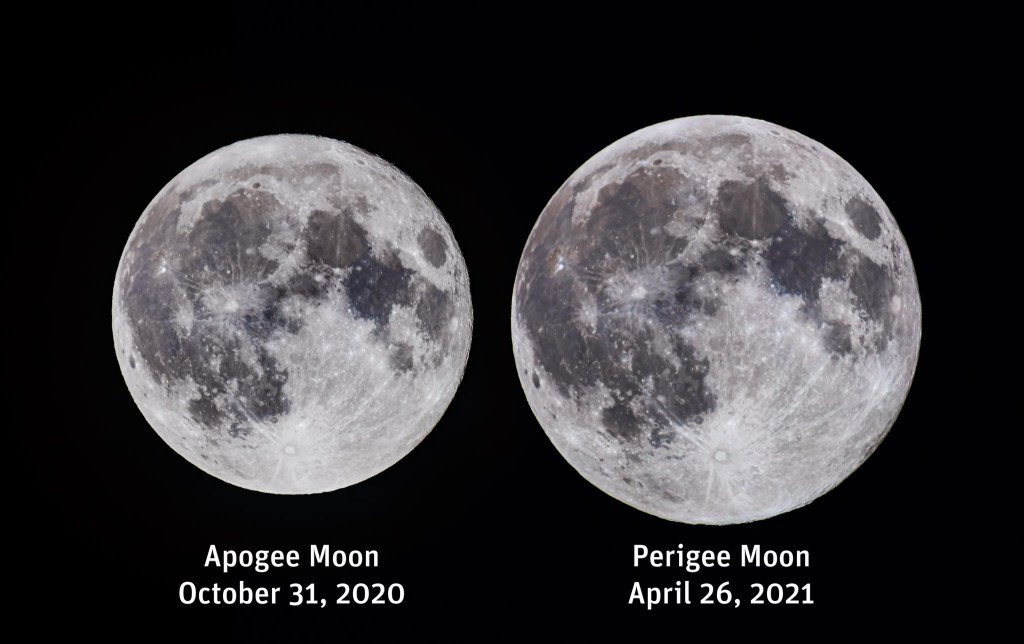
January 17 — The 2022 Mini-Moon
The Full Moon this night is the most distant, and therefore the smallest, of 2022. Shoot it and the Full Moon of July with identical gear to collect a contrasting pair of Mini and Super Moons, as above.

January 29 — Waning Moon and Morning Planets
By the end of January, Mercury and Venus have both moved into the morning sky, where they join Mars. The waning crescent Moon appears below magnitude 1.5 Mars this morning, as the famed red planet begins its fine appearance for 2022.
February
The main planet action migrates to the morning sky, while Zodiacal Light season begins in the evening.

February 16 — Mercury As a Morning Star
Though not a favourable elongation for northern latitudes, on February 16 Mercury reaches its highest angle away from the Sun low in the eastern dawn, below Venus and Mars, with Venus having just reached its greatest brilliancy (at a blazing magnitude -4.9!) on February 12, shining above much dimmer Mars. (Magnitude 0 to 1 is a bright star; magnitude 6 is the faintest naked-eye star; any magnitude of -1 to -5 is very bright.)
While at magnitude 0, elusive Mercury shines a magnitude and a half brighter than Mars, Mercury’s lower altitude will make it tougher to see. Use binoculars to pick it out. But Venus remains a brilliant and easy “morning star” for the next few months.

February 18 — Zodiacal Light Season Begins in the Evening
From sites away from light pollution look for a faint glow of light rising out of the southwest sky on any clear evening for the next two weeks with no Moon. This glow is caused by sunlight reflecting off cometary dust particles in the inner solar system. The next moonless window for the evening Zodiacal Light is March 20 to early April. Spring is the best season for seeing and shooting the Light in the evening sky.

February 27 — Moon Joins the Morning Planet Party
The waning crescent Moon appears very low below Mars and Venus, with Mercury still in view, and Saturn just beginning to emerge from behind the Sun.
March
Equinox brings a favourable season for great auroras, while the morning planets begin to cluster in the east.

March 1 on — Prime Aurora Season Begins
While great auroras can occur in any month, statistically the best displays often occur around the two equinoxes in spring and autumn. No one can predict more than 12 to 48 hours ahead (and still with a great deal of uncertainty) when a display will be visible from mid-latitudes. But watch sites such as SpaceWeather.com for heads-up notices.

March 1 on — Flaring Geosat Season Begins
In the weeks prior to the spring equinox, and in the few weeks after the autumn equinox, the string of communication satellites in geostationary orbit catch the sunlight and flare to naked-eye brilliance. Long-exposure tracked photos of the area below Leo (in spring, as here) will catch them as streaks, as the camera follows the stars causing the stationary satellites to trail.

March 12 — Venus and Mars in Conjunction
Venus and Mars reach their closest separation 4° apart low in the southeastern dawn sky.
March 20 — Equinox at 11:33 a.m. EDT
Spring officially begins for the northern hemisphere, autumn for the southern, as the Sun crosses the celestial equator heading north. Today, the Sun rises due east and sets due west, great for urban photo ops.

March 27 — Moon and a Planetary Triangle
The waning crescent Moon appears to the west of Venus and Mars, with Venus about 2° above Saturn. The view will be better the next morning, March 28, with the thin Moon directly below the close pairing of Venus and Saturn. But the Moon will be even lower in the sky, making it more difficult to sight.
April
Mercury puts on its best evening show of 2022, near the Pleiades, and with a possible comet nearby. The month ends with a very close conjunction of Venus and Jupiter at dawn.

April 1 — Milky Way Arch Season Opens
With the Moon out of view, the next two weeks bring good nights to shoot panoramas of the bright summer Milky Way as an arch across the sky, with the galactic core in view to the south. Catching the arch takes a very late-night shoot in early April. But the Milky Way moves into prime position two hours earlier each month.
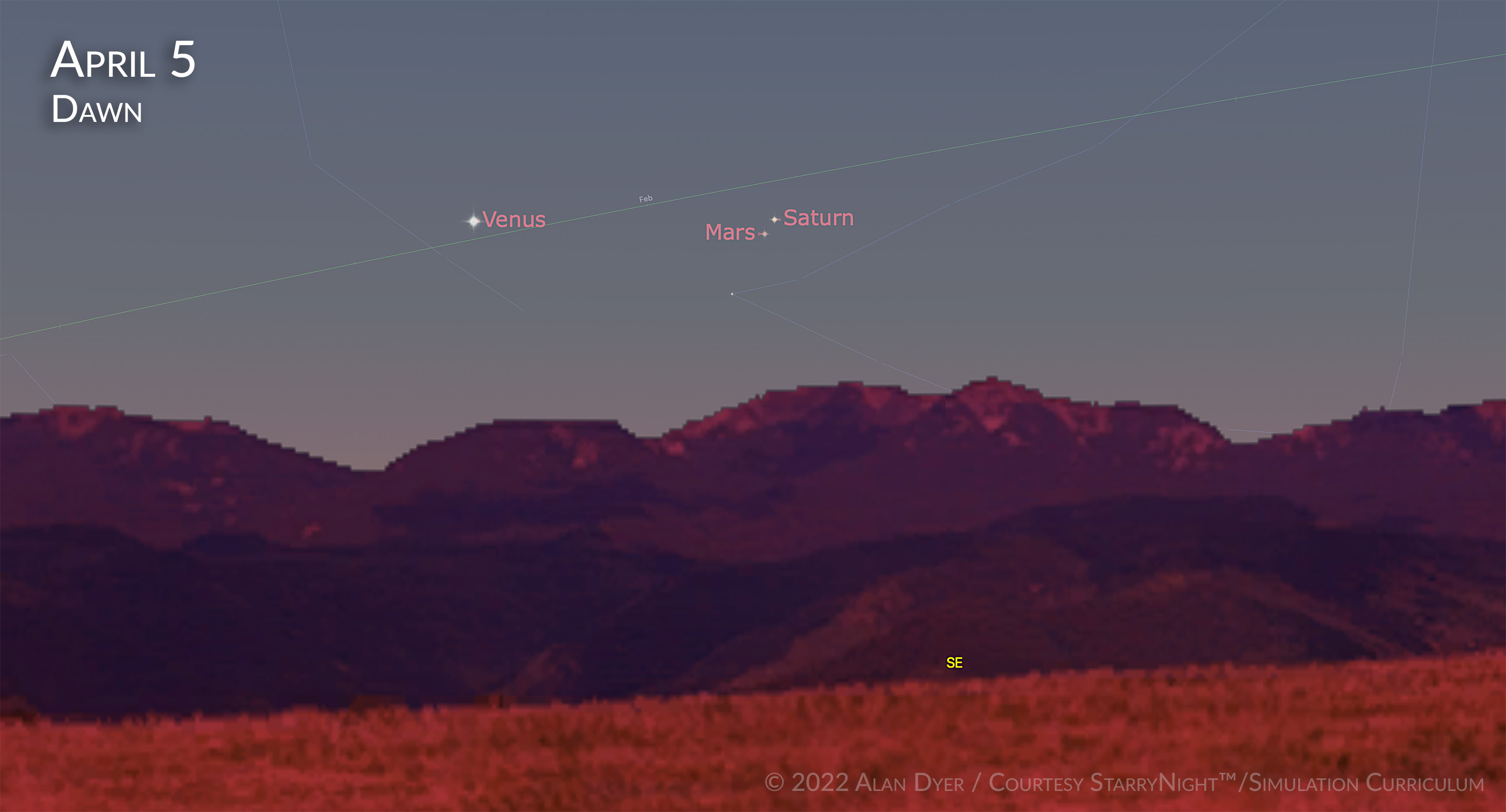
April 5 — Mars and Saturn 1/2° apart
The two planets appear almost the same brightness as a close “double star” in the dawn, not far from brighter Venus. Mars and Saturn will also be close the morning before, on April 4.

April 27 — Moon Joins Venus and Jupiter
Jupiter is now emerging from behind the Sun to meet up with Venus, for a grouping of the sky’s two brightest planets. On this morning the waning Moon appears 4.5° below the pair.

April 29 — Mercury Appears Beside the Pleiades
Just as Mercury reaches its greatest angle away from the Sun for its best evening appearance of 2022, it also appears just 1° away from the famous Pleiades star cluster low in the west.

April 30 — Venus and Jupiter in Close Conjunction
This is an early morning sight well worth getting up for! Venus passes only 1/3° below Jupiter this morning, but low in the eastern dawn sky. They will be almost as close on May 1.

April 30 — A Bonus Comet?
Comet PanSTARRS (C/2021 O3) might become bright enough to be a binocular object, and a photogenic target, right next to the Pleiades and Mercury pairing. Maybe! Some predictions suggest this comet could fizzle and break up earlier in April. Even if the comet survives and performs, you’ll need a very clear sky to the northwest to catch this rare sight.
May
On May 15-16 a totally eclipsed Moon shines red in the south at midnight for eastern North America, and in the southeast after sunset from the west.

May 15-16 — Total Eclipse of the Moon
The first of two total lunar eclipses in 2022 can be seen in its entirety from eastern North America, with totality beginning at 11:30 p.m. EDT on May 15 and lasting 85 minutes until 12:55 a.m. EDT. At mid-eclipse just after midnight from eastern North America the Moon will appear nearly due south, with the summer Milky Way to the east, shining brightly as the sky darkens during totality. Travel to a dark site to see and shoot the Moon and Milky Way.
Those in western North America see the totally eclipsed Moon rising into the southeast with some portion of the eclipse in progress, as depicted above. Once the sky darkens, the reddened Moon should become visible. Over a suitable landscape this should be a photogenic scene, though with the core of the Milky Way not yet risen. But a Milky Way arch panorama with a red Moon at one end will be possible. Choose your scenic site well!

See Fred Espenak’s EclipseWise.com page for details on timing and viewing regions. The dark region on this map does not see any of this eclipse.

May 18 — Red Planet Meets Blue Planet
Mars passes just 1/2° south of Neptune this morning, though both planets are very low in the east. They will appear close enough to frame in a telescope (the red circle is 1° wide).

May 24 — Moon with Mars and Jupiter
As it does every month in early 2022, the waning crescent Moon joins the morning planets, on this day grouping with Mars and Jupiter before dawn.

May 27 — Moon with Venus, plus Mars and Jupiter Close
Later that week the thinner waning Moon passes 4° below bright Venus, still shining at magnitude -4. But higher up Mars and Jupiter are reaching a close conjunction, passing about 1/2° apart on May 28 and May 29. Mars is still a dim magnitude +0.7; Jupiter is at -2.2.
June
Noctilucent cloud season begins for northerners, as does prime Milky Way core season for southerners. But the unusual sight is the line of all five naked eye planets, and in order!

June 1 on — Milky Way Core Season at its Prime
In early June with no Moon to interfere, and monthly for the next four months, the Milky Way core is ideally placed to the south through the night for nightscapes. However, for those at more northern latitudes the sky in June doesn’t get dark enough to make deep Milky Way shots feasible.
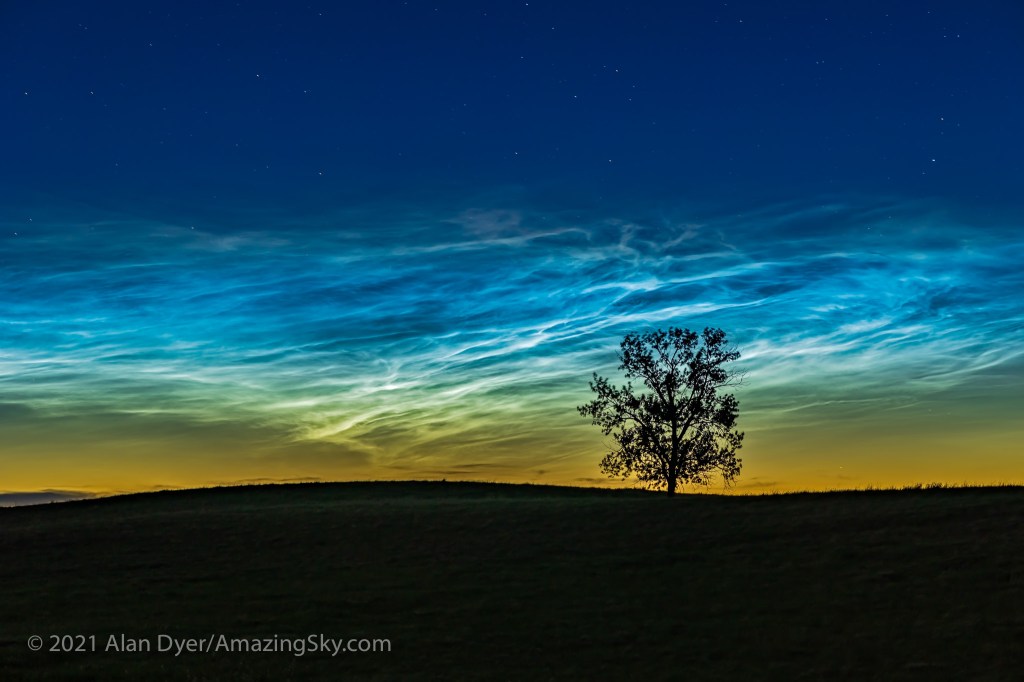
June 1 on — Noctilucent Cloud Season Begins
Instead, northerners are rewarded by the occasional sight of noctilucent clouds to the north through June and well into July (even into August for sub-arctic latitudes). The Sun illuminates these high-altitude electric-blue clouds during the weeks around the summer solstice. However, there is no predicting on what night a good display will appear.

June 14 — First of the Summer Supermoons
The Moon is full on the night of June 14-15, when it also reaches one of its closest perigees (closest approach to Earth) of 2022. In modern parlance, that makes it a “supermoon.” It will look impressive shining low in the south all night, with the low-altitude “Moon illusion” making it appear even larger. It is a good night for nightscapes with the Moon, though exposures are a challenge — try blending short exposures for the lunar disk with long exposures for the sky and ground.
June 21 — Solstice at 5:14 a.m. EDT
Summer officially begins for the northern hemisphere, winter for the southern, as the Sun reaches its most northerly position above the celestial equator. The Sun rises farthest to the northeast and sets farthest to the northwest, and the length of daylight is at its maximum.

June 24 — All Planets in a Row
As fast-moving Mercury rises into view at dawn in mid-June, it completes the set to provide the rare chance to see all five naked eye planets — Mercury, Venus, Mars, Jupiter and Saturn — in a row along the ecliptic, the path of the planets. Even more fun, they are in the correct order out from the Sun! The scene shown here depicts the morning of June 24, when the Moon sits between Venus and Mars, just where it should be in order of distance from the Sun as well.
A panorama of several stitched images will be best for capturing the scene which spans 120°. Uranus and Neptune are there, too, though not in order and faint enough (below naked eye brightness) they will be tough to capture in a wide-angle scene. Long exposures with a tracker might do the job! But by the time Mercury rises high enough, the sky might be getting too bright to nab the faintest planets.

June 26 — Inner World Gathering
The select club of just inner worlds gathers for a meeting this morning, with the waning crescent Moon 2.5° above Venus. The rising stars of Taurus serve as a fine backdrop in the dawn twilight.
July
Once the pesky full supermoon gets out of the way, the heart of Milky Way season will be in full swing.

July 13 — Second of the Summer Supermoons
It will be a battle of summer supermoons in 2022! But July’s Moon wins on a technicality, as it is ever so slightly closer (by about 200 km) than the June Moon. It also appears slightly farther south, so lower in the sky than a month before. This is a good night for lunar (looney?) photo ops, though don’t expect to see the Milky Way as shown here — moonlight will wash it out.
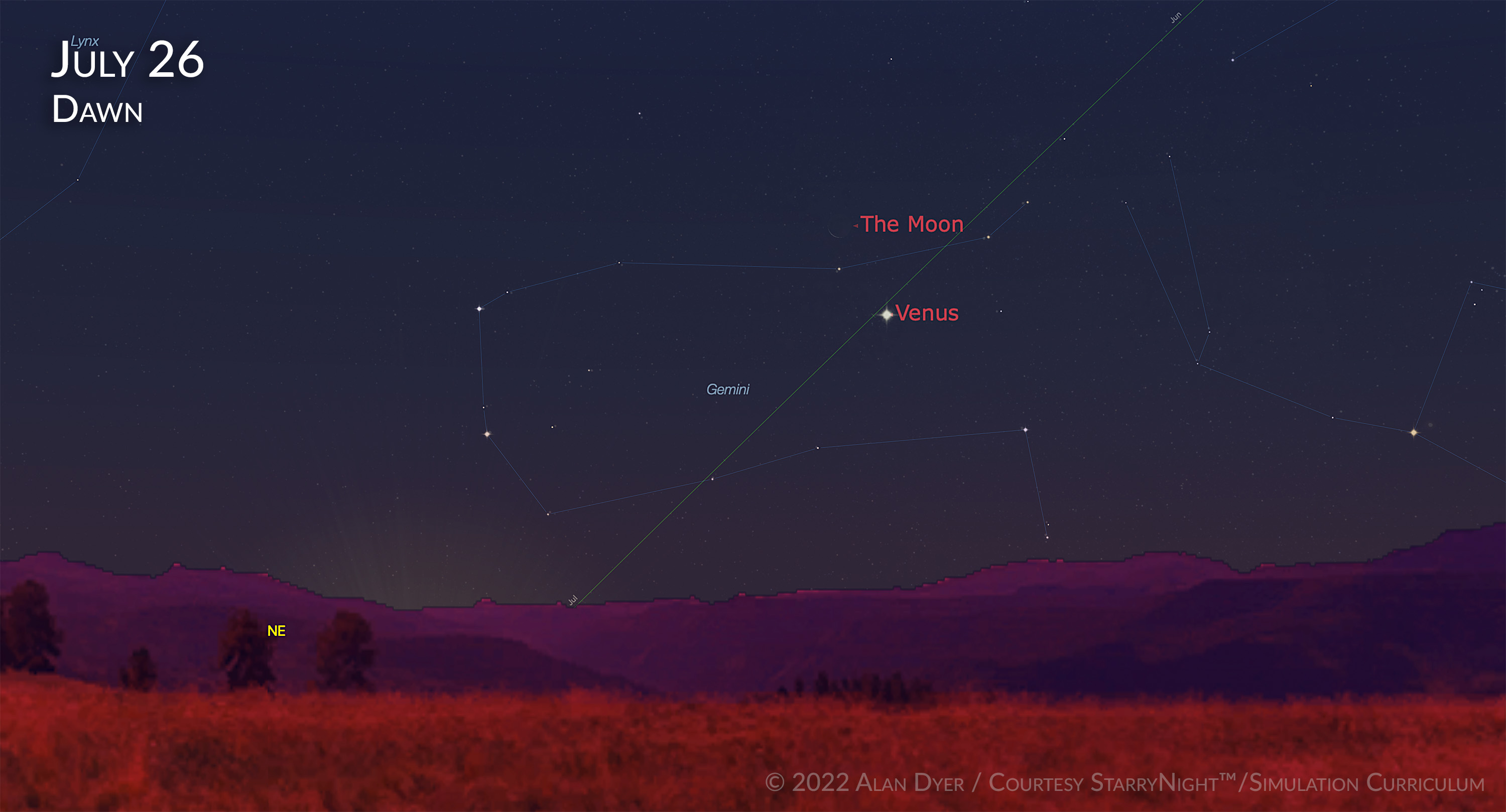
July 26 — Dawn Moon and Morning Star
Another photo op comes on July 26 when the waning crescent Moon passes 3° above Venus, still bright at magnitude -3.8. The last week of July and the first week of August are prime weeks for shooting the Milky Way core to the south over scenic nightscapes, assuming we get clear skies free of forest fire smoke.
August
The popular Perseid meteors are mooned out, but late in the month under dark skies, the Milky Way reigns supreme.

August 1 — Red Planet Meets Green Planet
As it did in May, Mars meets up with an outer planet, passing close enough to Uranus this night for both to appear in a low-power telescope field (the red circle is 2° wide).

August 12-13 — Perseid Meteor Shower Peaks
The annual and popular Perseid meteor shower peaks tonight, but with a nearly Full Moon in Aquarius (as shown above) lighting the sky all night. Under a transparent sky, you’ll still see some bright meteors radiating from Perseus in the northeast. But you’ll need to be patient, as bright meteors are infrequent. But why not enjoy a moonlit summer night under the stars anyway?


August 14-15 — Saturn at Opposition
Saturn is at its closest and brightest for 2022 tonight, rising at sunset and shining due south in eastern Capricornus in the middle of the night. Through a telescope the rings appear tipped at an angle of 13°, about half the maximum possible at Saturnian solstices. The northern face of the rings is tipped toward us.
August 16 on — Prime Milky Way Season
After it spoils the Perseids, the waning gibbous Moon takes a long time to get out of the way. As it does so, mid-August brings some good nights to shoot the Milky Way to the south as the rising waning Moon to the east illuminates the landscape with warm “bronze hour” lighting. By the last week of August, nights are finally moonless enough for an all-night dark-sky shoot.

August 25 — Thin Moon Above Venus
Those enjoying an all-nighter under the stars on August 24 will be rewarded with the sight of the thin waning Moon and Venus rising together at dawn on August 25. They will be 5° apart in the morning twilight, against the backdrop of the winter stars rising.
September
It’s Harvest Moon time, with this annual special Full Moon coming early before the equinox this year.

September 1 on — Prime Aurora Season Begins
As in spring, some of the best weeks for sighting auroras traditionally occur around the autumn equinox. Solar activity is on the rise in 2022, heading toward an expected solar maximum in late 2024 or 2025. So we can expect some good shows this year, including some that should extend south into the northern half of the lower 48 in the U.S.

September 10 — Full “Harvest” Moon
Occurring 12 days before the equinox, this is the closest Full Moon to the equinox, making it the official Harvest Moon of 2022. With it occurring early this year, the Harvest Moon will rise well south of due east at sunset and set well south of due west at sunrise on September 11.
Planning apps such as PhotoPills or The Photographer’s Ephemeris can help you plan where to be to place the rising or setting Moon over a scenic foreground.

September 22 — Equinox at 9:04 p.m. EDT
Autumn officially begins for the northern hemisphere, spring for the southern, as the Sun crosses the celestial equator heading south. As in March, the Sun rises due east and sets due west for photo ops on east-west aligned roads, as above.
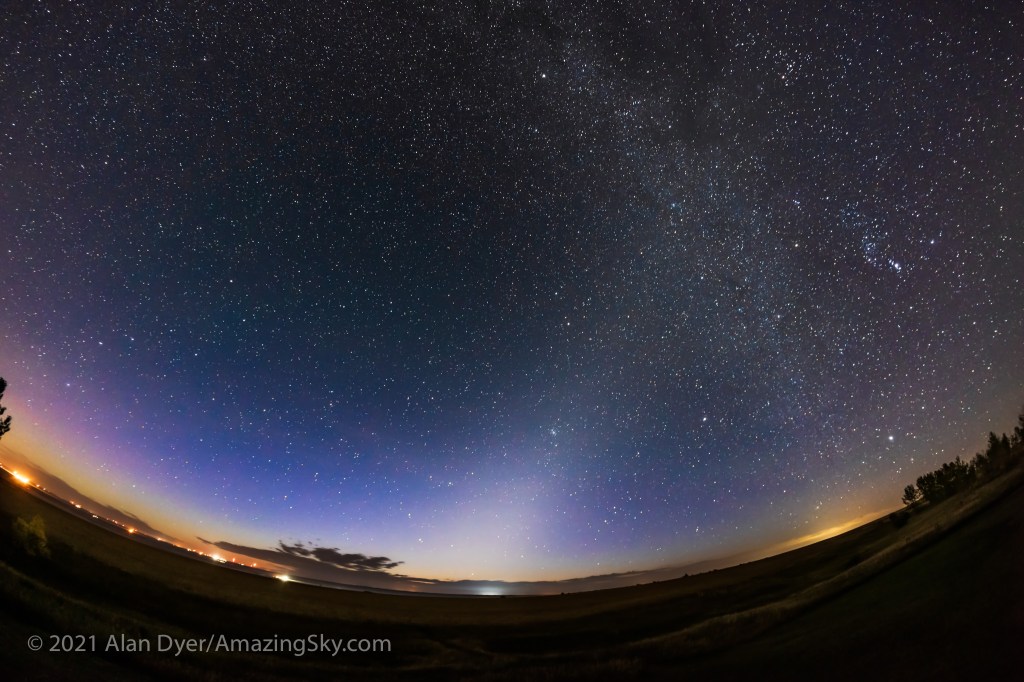
September 23 — Zodiacal Light Season Begins in the Morning
With no Moon for the next two weeks, from sites away from light pollution look to the pre-dawn sky for a faint glow of light rising out of the east before twilight brightens the morning sky. The end of October brings another moonless morning window of opportunity for the Zodiacal Light.
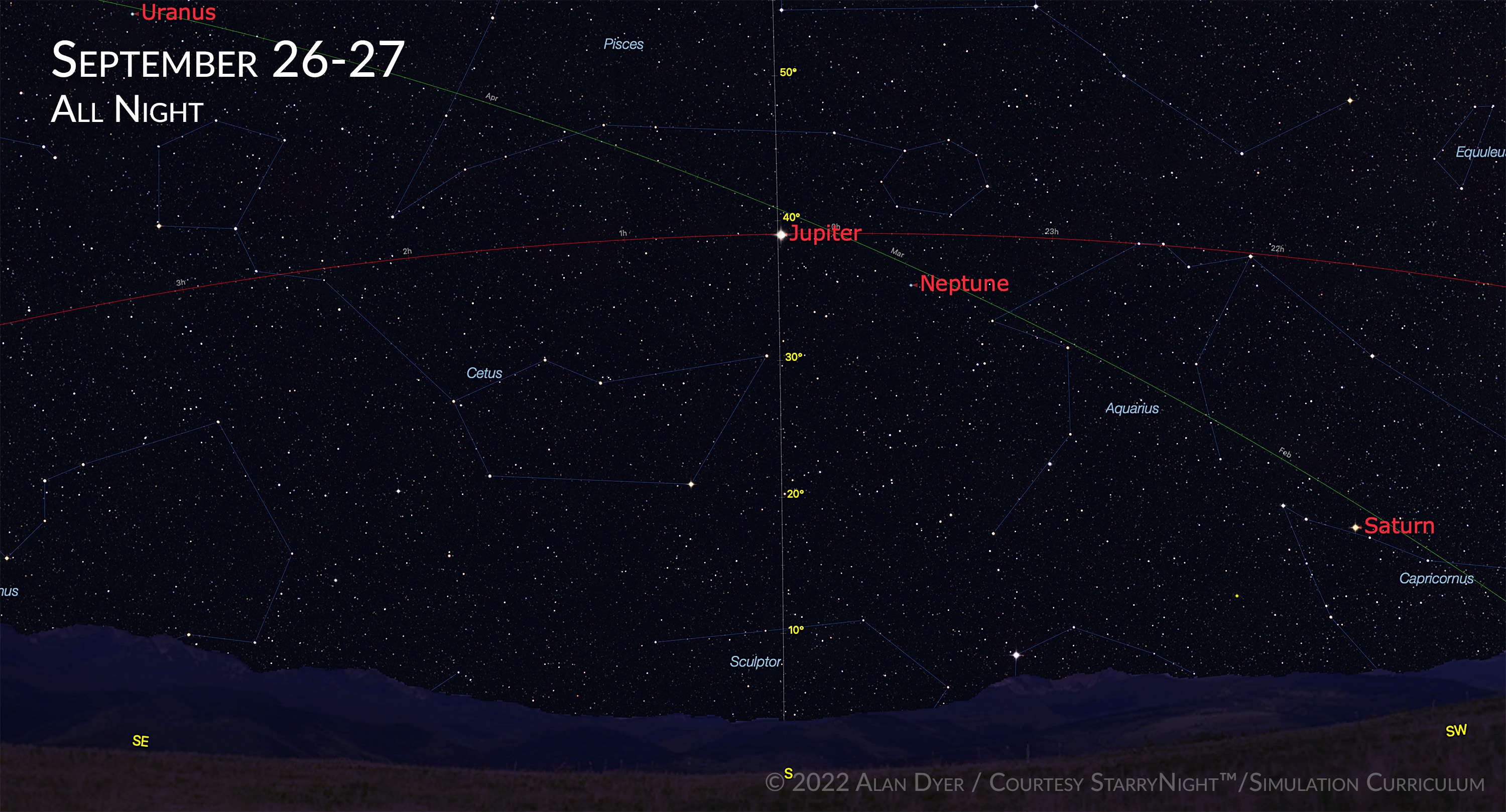
September 26-27 — Jupiter at opposition
Jupiter, now in southern Pisces, reaches its closest and brightest for 2022 tonight, also rising at sunset and shining due south in the middle of the night. Jupiter has now moved far enough along the ecliptic to place it high in the sky for northern observers, providing us with sharper telescope views than we’ve had for many years.
October
Mercury rises into the dawn, while the Moon occults the planet Uranus.
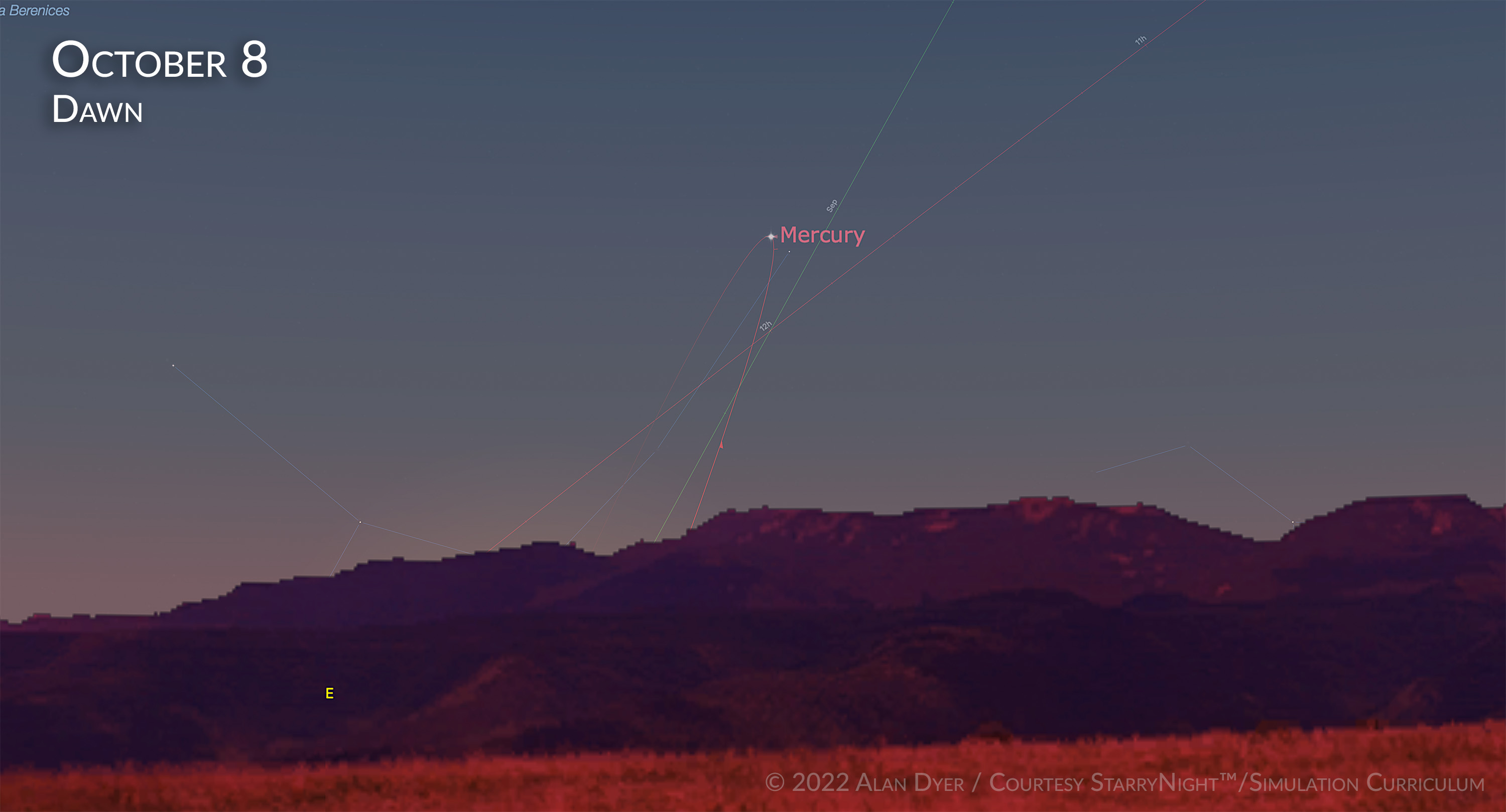
October 8 — Mercury at Its Morning Best
This is the best time to sight Mercury in the morning, as it reaches its greatest angle away from the Sun today, while the steep angle of the ecliptic on autumn mornings swings the inner planet up as high and clear from horizon haze it can get for the year.

October 11 — Moon Hides Uranus
While many observers might not have seen Uranus, here’s a chance to see it, then not see it! The waning gibbous Moon passes in front of magnitude 5.7 Uranus this night, occulting the planet for about an hour around midnight. Exact times will vary with location. Seeing the planet reappear from behind the dark limb of the Moon, as shown here, will be the easiest sighting, but a telescope will be essential.

October 21 — Orionid Meteor Shower Peaks
With both the Perseids and Geminids mooned out this year, the weaker but reliable Orionids remain as perhaps the best meteor shower of 2022. The meteors (expect only about 10 per hour) all appear to radiate from northern Orion, which doesn’t rise until just before midnight. Mars shines bright above the radiant point.

October 25 — Partial Solar Eclipse for Europe
While my list is aimed at North American stargazers, I should mention the partial eclipse of the Sun (there are no total solar eclipses this year) that observers across parts of Asia, Africa, Europe and the U.K. (as shown above) can see.
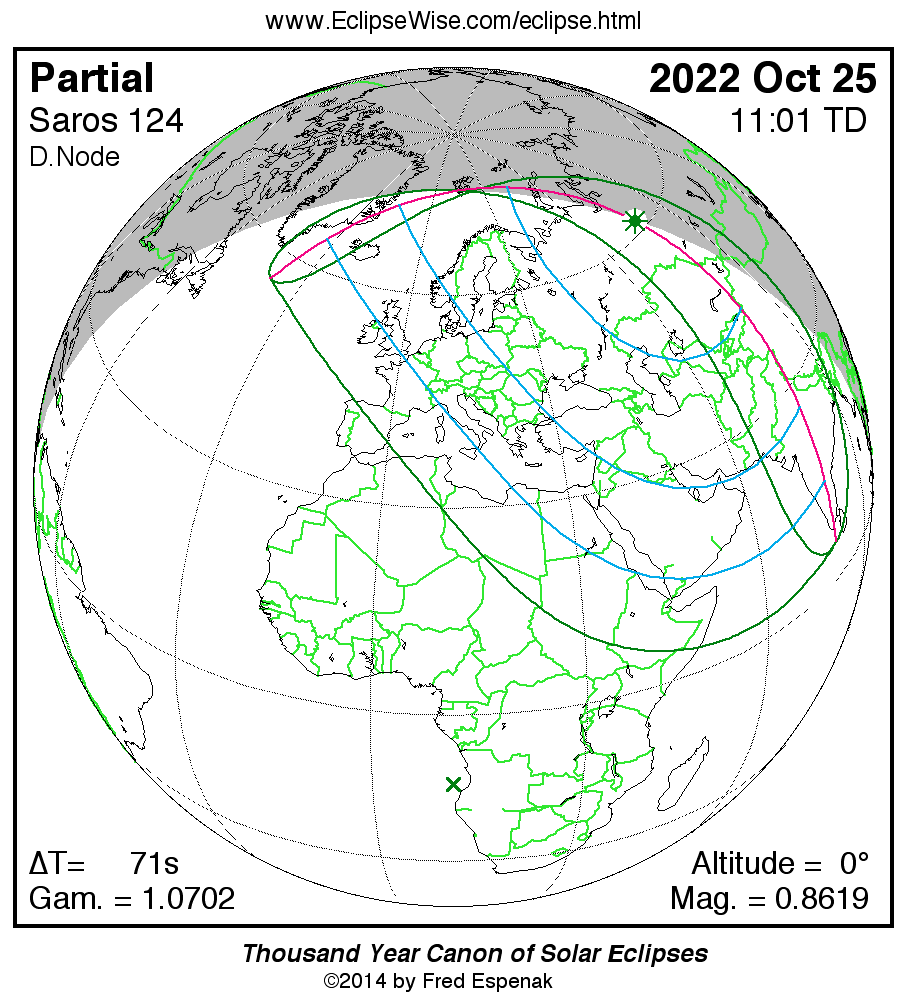
At maximum eclipse from Siberia about 86% of the Sun’s disk will be covered. No part of the eclipse is visible from North America. For details, see the page at EclipseWise.com.

October 30 — Mars Begins Retrograde Motion
Mars stops its eastward motion this night and begins to retrograde westward for the next two months centred on the date of opposition, December 7. It then stops retrograding and resumes its prograde motion on January 12, 2023. Naked-eye Mars watchers can follow the changing position of Mars easily, using the stars of Taurus, including yellowish Aldebaran below, as a guide.
November
The second total lunar eclipse of 2022 brings a red Moon to the skies over western North America.
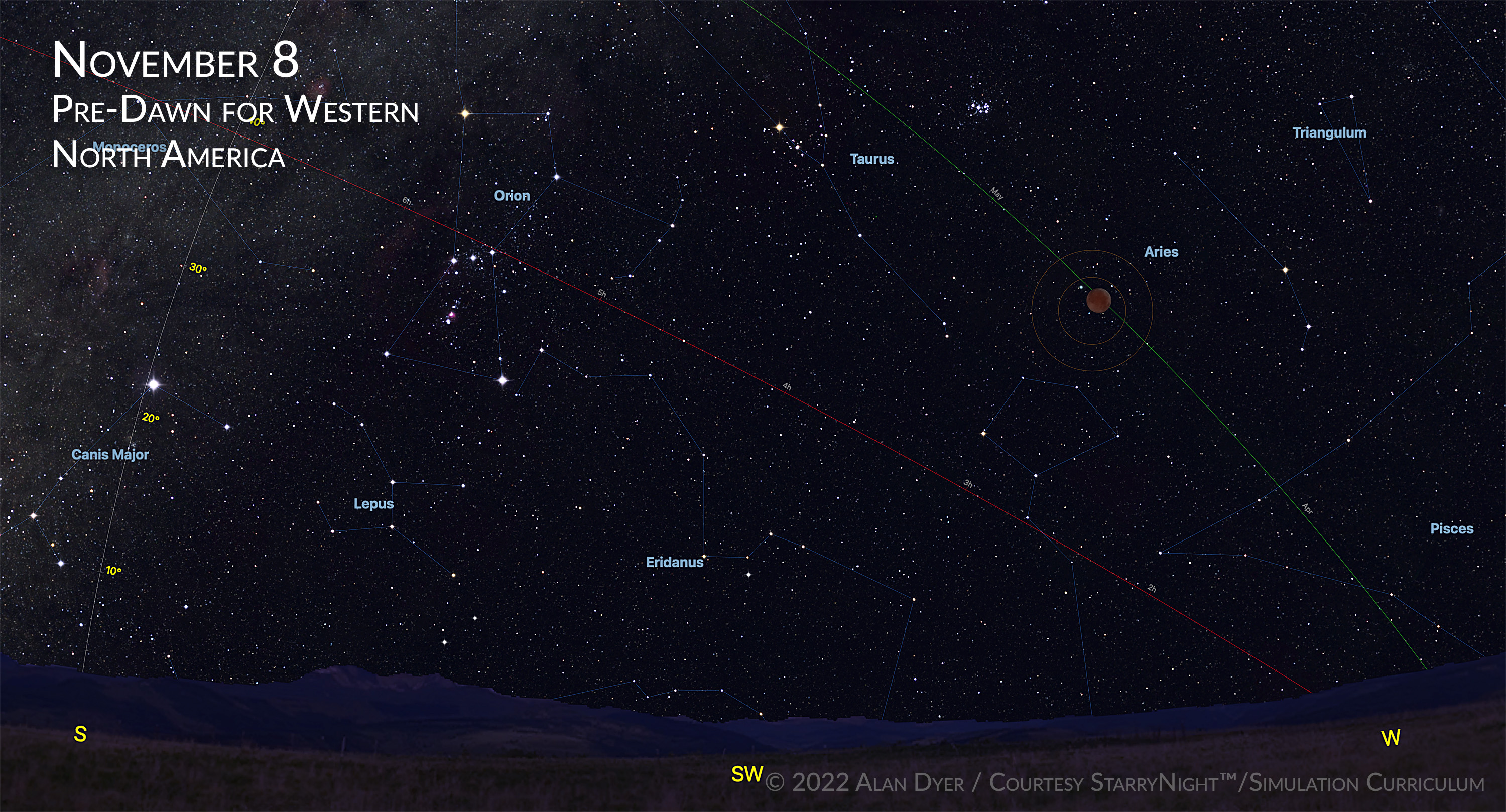
November 8 — Total Eclipse of the Moon
In a mirror-image of the May eclipse, this eclipse also lasts 85 minutes, but can be seen best from western North America. From the east, the Moon sets at dawn with some portion of the eclipse in progress.
But from the west the Moon is fully eclipsed during the wee hours of November 8, with the Moon sitting west of the winter Milky Way, making for good wide-angle photos.
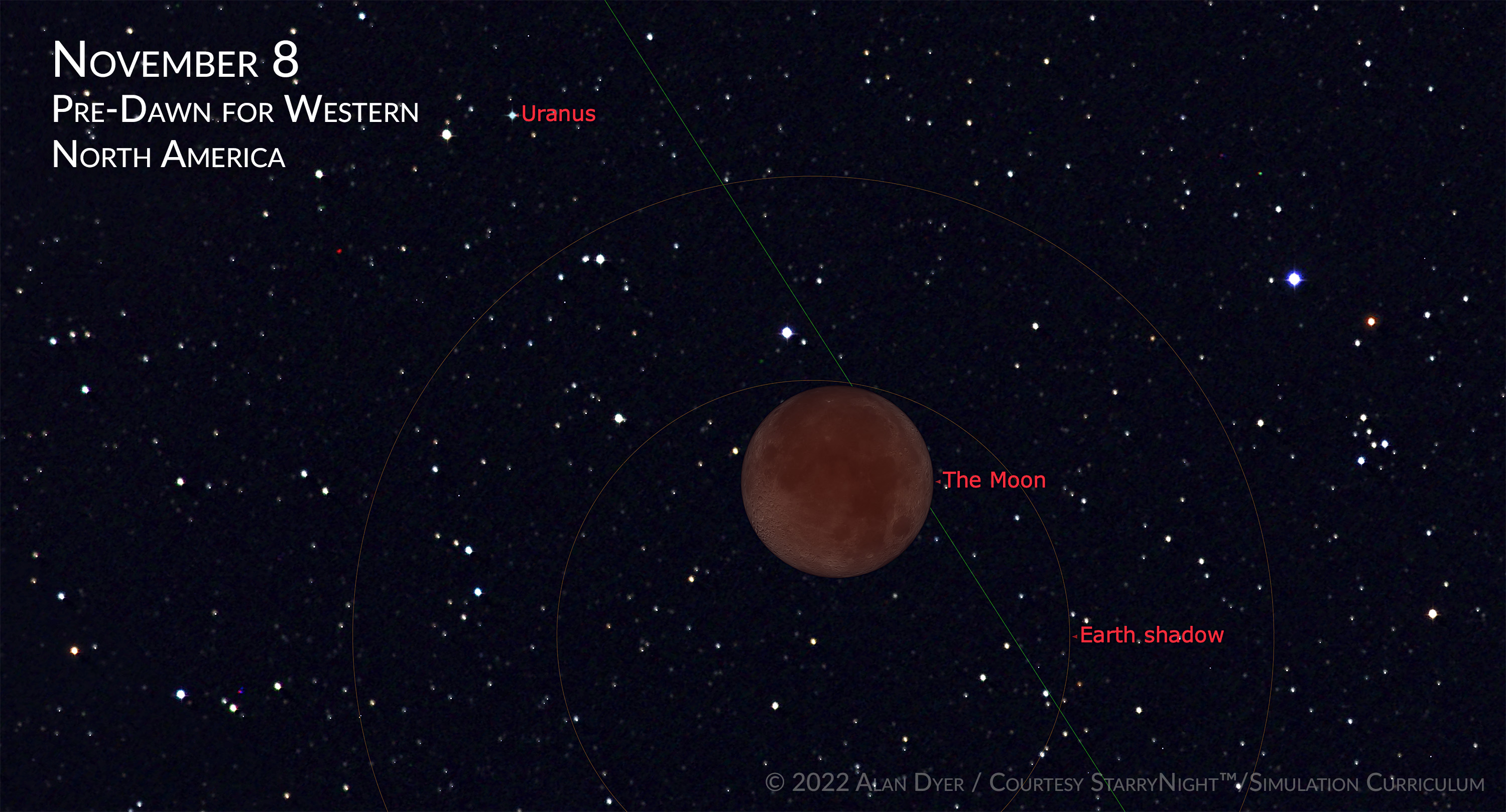
The Moon sits just a degree west of Uranus during totality. From Asia the eclipsed Moon actually passes in front of the planet for a rare eclipse and occultation combination. We have to be content with seeing the green planet east of the reddened Moon. A telescope with 600mm focal length should nicely frame the pairing.
The total phase of the eclipse begins at 5:16 a.m. EST (3:16 a.m. MST) and ends at 6:41 a.m. EST (4:41 a.m. MST).

For details see Fred Espenak’s EclipseWise site. As above, the dark region on this map does not see any of this lunar eclipse.
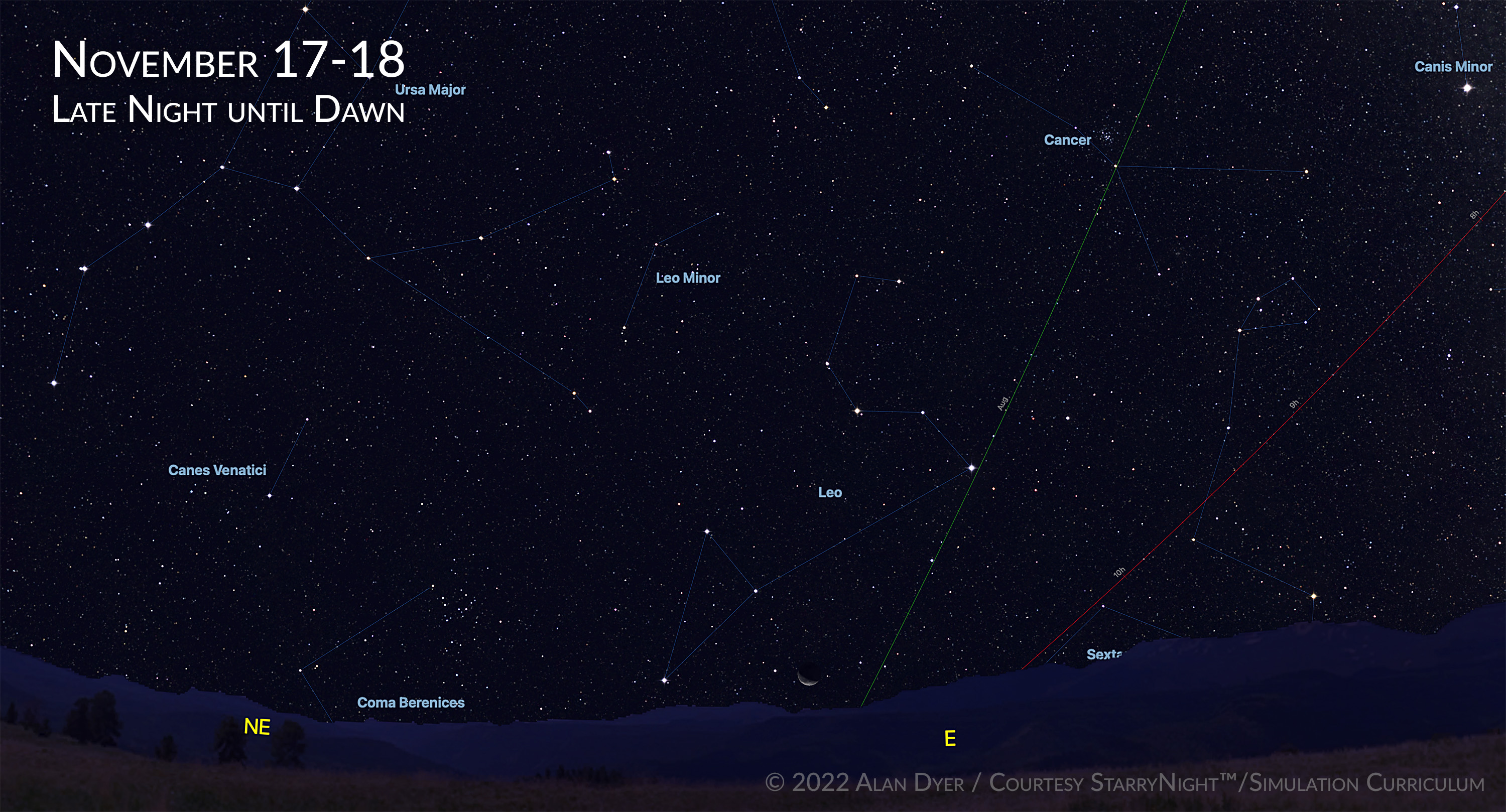
November 17 — Leonid Meteor Shower Peaks
As with the Orionids, this is normally a weak shower, but this year we have to be content with watching the weak showers. The waxing crescent Moon shining below Leo (as shown above) shouldn’t hinder observations of the Leonids too much. But with Leo not rising until late, this is another shower that requires a long, late night to observe.
December
Mars reaches its closest point to Earth since October 2020, with the Moon occulting Mars on peak night.

December 1 — Mars at Its Closest
Mars is closest to Earth this night, at 81 million kilometres away. This is not as close as it was in October 2020 when it was 62 million km away. Its disk then appeared large, at 22.5 arc seconds across. Maximum size on this night is 17.2 arc seconds, still good enough for fine telescope views.
Take the opportunity on every clear night to view Mars, as this is as good as we will see the planet until the early 2030s. As it happens, the most interesting side of Mars, featuring the prominent dark Syrtis Major region and bright Hellas basin (shown above in a simulated telescope view), faces us in North America on closest approach night.

Wide-angle views and photos will also be impressive, with reddish Mars shining brightly at magnitude -1.8 in Taurus with its photogenic star clusters, and near the winter Milky Way.

December 7/8 — Mars at Opposition
This is the night Mars is officially at opposition, meaning it lies directly opposite the Sun and shines at its brightest. As it rises at sunset and into the early evening (as above), it is accompanied by the Full Moon, also at opposition this night, as all Full Moons are.

By midnight (above), the Moon and Mars lie due south high in the sky. If you can keep warm and keep an eye on Mars over this long night of opposition, you’ll see surface features on Mars change as the planet rotates, bring new areas into view, with the fork-shaped Sinus Meridiani region rotating into view as triangular Syrtis Major rotates out of sight.
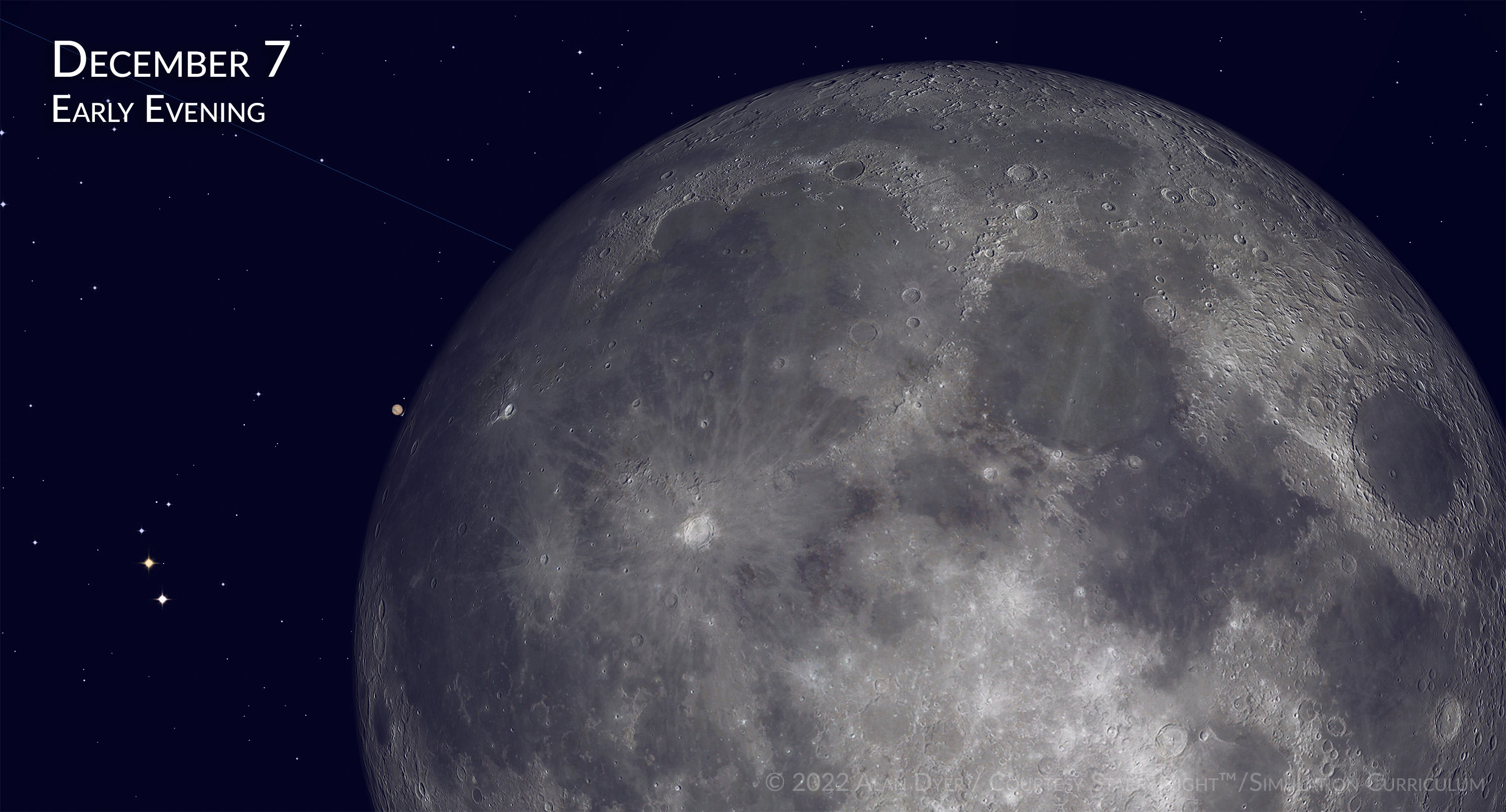
December 7 — Moon Occults Mars
This is very rare! On opposition night, not only does the Full Moon appear close to Mars, it actually passes in front of it during the early evening for North America. The occultation lasts about an hour, and exact times will vary with location. Binoculars will show the event, as will even the naked eye. But the best view will be through a telescope (as above), where you will be able to see the edge of the Moon cover Mars over about half a minute. Ditto on the reappearance. This is an event worth traveling to seek out clear skies if needed.
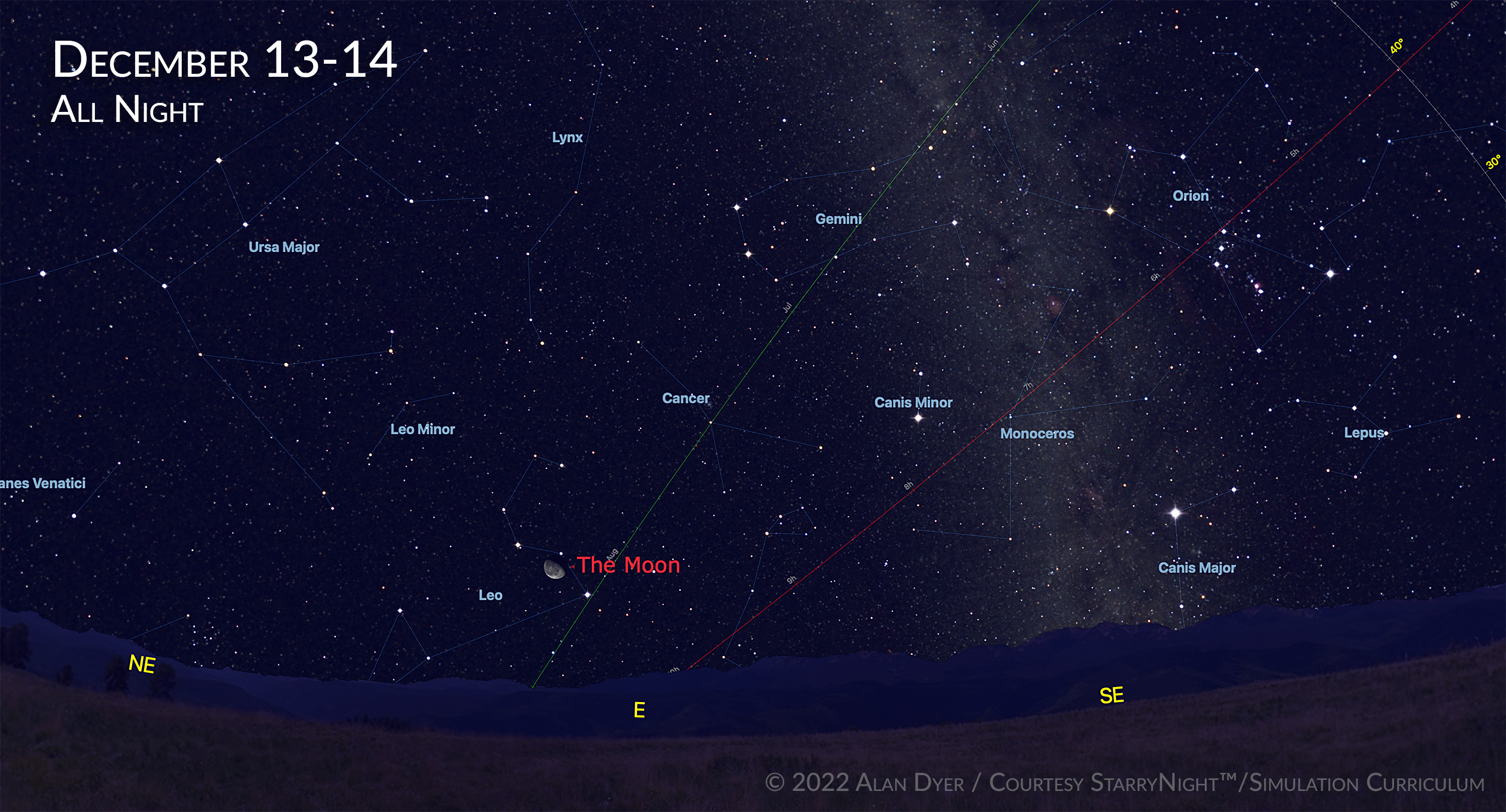
December 13-14 — Geminid Meteor Shower Peaks
The most prolific meteor shower of the year peaks with a waning gibbous Moon rising about 10 p.m. local time (as above), lighting the sky for the rest of the night. But the early evening is dark, and with Gemini just rising we might see some long Earth-grazing fireballs from the Geminids. So certainly worth a watch on a cold December night.
December 21 — Solstice at 4:48 p.m. EST
Winter officially begins for the northern hemisphere, summer for the southern, as the Sun reaches its most southerly position below the celestial equator. The Sun rises farthest to the southeast and sets farthest to the southwest, and the length of daylight is at its minimum.

December 24 — Inner Planets at Dusk
On Christmas Eve the waxing crescent Moon joins Mercury and Venus low in the southwest evening twilight. Mercury is three days past its greatest elongation, so is easier to see than usual, though it will be three and a half magnitudes fainter than magnitude -3.9 Venus.
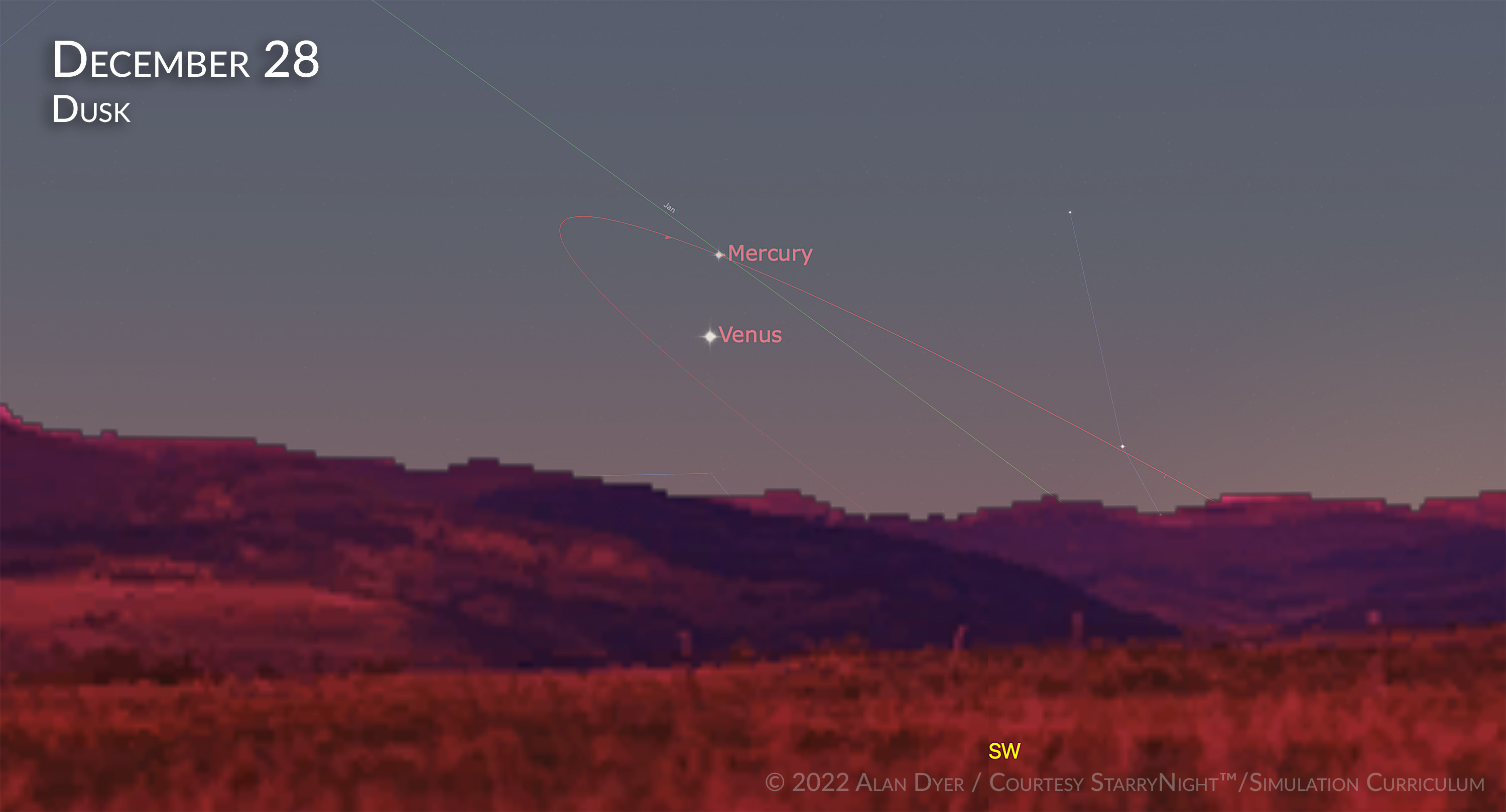
December 28 — Mercury and Venus in Conjunction
This evening, descending Mercury passes 1.5° above Venus, now ascending into the evening twilight sky. Venus is just beginning what will be a spectacular evening appearance for early 2023, featuring close conjunctions with Saturn (on January 22, 2023) and Jupiter (on March 1, 2023).
Good luck, good viewing, and clear skies in 2022!
— Alan, January 3, 2022/ © 2022 AmazingSky.com



Thanks, Alan. I know how much time you had to spend doing this, and I very much appreciate it. I have just been entering events into my 2022 datebook.
Thanks for including the occultation of Mars! This is missing in many other such lists.
cheers, Dave Chapman
Dartmouth NS Canada https://linktr.ee/DaveChapman
>
Thanks! Not sure why anyone would miss it, as it is one of the main events this year. What I did not include, and the Handbook misses as well, is the occultation of Mercury on Oct 24. Even IOTA does not include it in their main listing of planet occultations for 2022. But it is visible only from my area in the short window between moonrise (it’s a old Moon 1 day before new) and sunrise. It’s likely too close to the Sun for IOTA to list but we can see it here. In theory!